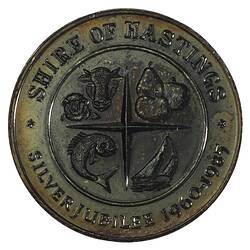Hastings is situated on the western shore of Western Port on a natural deep-water harbour, 61 km south of Melbourne. The original inhabitants of the area were the Burinyung-balluk clan of the Bunerong people.
The first European to enter Western Port was George Bass in a whaleboat, on 5 January 1798. Bass sailed along the western passage of Western Port, past the site of the future township of Hastings, and up to the Tooradin inlet.
The Lady Nelson was the first decked vessel to enter Western Port Bay. It arrived under the command of John Murray in 1801. During this visit Victoria's first garden was planted on Churchill Island, Western Port. Officers from the Lady Nelson prepared the first chart of Western Port. Leaving Western Port, the Lady Nelson became the first ship known to have entered Port Phillip Bay, arriving in 1802. The Lady Nelson later carried people to Victoria's first settlement at Sorrento in 1804, and was the first known vessel to traverse the southern coastline and to travel through Bass Strait from west to east.
William Thomas was the appointed Protector of the Aborigines of this area in April 1839, and in February 1840 he took a group of 57 Aborigines and they camped at 'Teyup'. The journal of William Thomas gives a wealth of information on this matter.
The pastoral lease of the area, which includes Hastings, was granted to Martha Jane King, one of the few women who were granted a lease. It was later sold and subdivided. In the 1840s fishing and fruit-growing became important local industries. The pier and fishing shed, both erected in the 1860s, are still in use and part of the scene at Hastings today. Fish is still sold from the fishing shed. Fish from Hastings was taken to Frankston in a 'fish wagon'. A description of the heyday of fishing (c1894) has been given by Mrs Fellowes: 'it was long, painted red and stacked with rows of baskets after the fishing. When the fishermen were not busy the youngsters had great fun packing on the little truck and sending it flying the length of the jetty and bashing the log and piles at the end. There was a time Hastings had a Regatta and the fishing fleet turned out in all its glory and Hastings public came alive. Let a little greased piglet loose as a prize for the catcher as it raced around Hastings well greased, almost impossible to grip.' (Western Port Pioneers and Preachers by Valda Cole, The Hawthorn Press Pty. Ltd. 1975, page 40).
In February 1861 the town was gazetted as 'Tyabb'; the name changed to 'Hastings' in 1889. The current Tyabb township grew up north of 'old Tyabb'. The cemetery situated at Hastings is still known as the Tyabb Cemetery in the area of 'old Tyabb'.
In 1911 Crib Point, with secluded entry through Hann's Inlet [15 km south of Hastings], was selected as the site for Australia's premiere training base in 1911 by Admiral Sir Reginald Henderson. The first buildings were completed in 1914. Known as the Flinders Naval Depot and now HMAS Cerberus, it remains a state-of-the-art training centre for the Navy.
In the twentieth century Hastings also saw industrial development. BP and Esso operated oil refineries at Crib Point (now closed). BHP Steel Flat established a Western Port Works at Hastings in 1969, and their tanks are now part of the landscape of the area. In January 2001, the 5 millionth tonne of BHP 'Colourbond' steel was produced at the Western Port Works.
Hastings today has a diversity of native vegetation. The white mangroves which grow and thrive in Western Port are the most southern of any in the world. Hastings has three hotels, three primary schools and one secondary college. Police Station, a Fire Brigade, swimming pool, Family Leisure Centre, and coastal wetlands boardwalk and two supermarkets. Passenger trains run daily.
In 1985 the Shire of Hastings issued a medal to commemorate the Sesquicentenary of Victoria [NU 20701].
References:
Shirley Davies of the Hastings-Western Port Historical Society, People's Voice Australian Community History website http://www.peoplesvoice.gov.au/stories/vic/hastings/hastings_c.htm, accessed 28/11/2003.
More Information
-
Keywords
-
Localities
-
Authors
-
Article types

